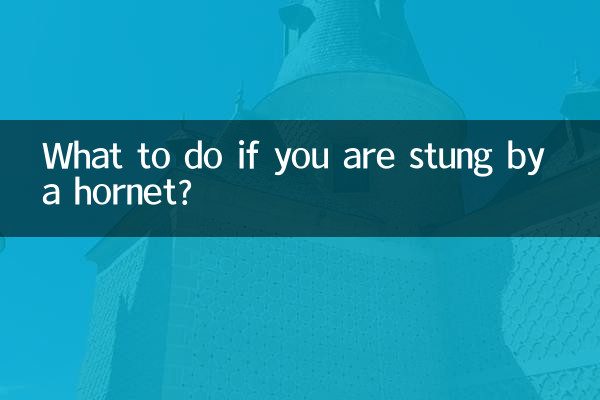What to do if you are stung by a hornet?
Recently, with the increase in outdoor activities in summer, incidents of killer wasp stings have occurred frequently and have become one of the hotly debated health topics on the Internet. Hornet wasps are highly venomous, and if stings are not treated promptly, they may lead to severe allergic reactions or even shock. This article will combine the hot content and authoritative medical advice in the past 10 days to provide you with structured solutions.
1. Emergency treatment steps after killer wasp stings

| step | Operating Instructions | Things to note |
|---|---|---|
| 1. Get out of danger | Stay away from cellular areas immediately | Avoid swiping to aggravate the swarm |
| 2. Check the wound | Observe whether there are any stinger residues | Do not remove it directly with your hands |
| 3. Remove the stinger | Scrape off the edge of a bank card | Avoid squeezing the poison sac |
| 4. Wound treatment | Rinse with soapy water for 15 minutes | Direct disinfection with alcohol is prohibited |
| 5. Apply cold compress to reduce swelling | Cold compress wrapped in ice pack and towel | No more than 20 minutes each time |
2. Warning symptoms that require immediate medical attention
| Symptom type | Specific performance | Hazard level |
|---|---|---|
| allergic reaction | Skin rash all over the body, difficulty breathing | ★★★★★ |
| nervous system | Dizziness, confusion | ★★★★ |
| circulatory system | Sudden drop in blood pressure, weak pulse | ★★★★★ |
| local symptoms | The wound festers and continues to swell | ★★★ |
3. Latest hot-spot related data (last 10 days)
| area | sting cases | Main scenes | peak period |
|---|---|---|---|
| South China | 47 cases | Orchard picking | 9-11 a.m. |
| East China | 32 cases | Hiking | Evening 16-18 pm |
| southwest region | 28 cases | Surrounding the farmhouse | Frequent throughout the day |
4. Preventive measures and expert advice
1.Clothing options:Wear clothing with light-colored smooth fabrics and avoid bright colors and plush materials that may attract bees.
2.Odor management:Avoid using scented products such as perfume and hairspray during outdoor activities, as the smell of sweat can also attract bee swarms.
3.Emergency Preparedness:Always carry antihistamines (such as loratadine) and corticosteroid ointments in your hiking bag.
4.Environment recognition:Pay attention to tree trunks, rock crevices and other possible nesting places, and keep a safe distance of more than 5 meters.
5.Special groups:People with a history of allergies should carry an epinephrine auto-injector (EpiPen) with them.
5. Clarification of folk misunderstandings
1.Misunderstanding:Disinfect the wound with urine. Actual: Bacterial infection may occur and must be flushed with clean water.
2.Misunderstanding:Run away immediately. Correct: You should retreat slowly to avoid triggering the swarm’s pursuit instinct.
3.Misunderstanding:All bee venom can be sucked out. Fact: Hornet venom contains hyaluronidase and is absorbed within 3 seconds.
4.Misunderstanding:Applying toothpaste works. Truth: Alkaline substances may aggravate tissue damage, so cold compress is the correct method.
The "Butterfly Warning Map" that has been hotly discussed on social media recently shows that August is a period of high incidence of stings, with the highest number of alarms in a single day reaching 83. Special reminder from experts: Avoid drinking alcohol within 24 hours after being stung, as alcohol will accelerate the spread of toxins. It is recommended to collect this first aid guide and forward it to relatives and friends who often engage in outdoor activities. It can save lives at critical moments.

check the details

check the details